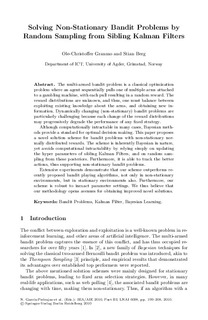| dc.contributor.author | Granmo, Ole-Christoffer | |
| dc.contributor.author | Berg, Stian | |
| dc.date.accessioned | 2011-02-25T12:03:29Z | |
| dc.date.available | 2011-02-25T12:03:29Z | |
| dc.date.issued | 2010 | |
| dc.identifier.citation | Granmo, O.-C., & Berg, S. (2010). Solving Non-Stationary Bandit Problems by Random Sampling from Sibling Kalman Filters. In N. García-Pedrajas, F. Herrera, C. Fyfe, J. Benítez & M. Ali (Eds.), Trends in Applied Intelligent Systems (Vol. 6098, pp. 199-208): Springer Berlin / Heidelberg. | en_US |
| dc.identifier.isbn | 978-3-642-13032- | |
| dc.identifier.issn | 0302-9743 | |
| dc.identifier.uri | http://hdl.handle.net/11250/137863 | |
| dc.description | Published version of an article from Lecture Notes in Computer Science. Also available at SpringerLink: http://dx.doi.org/10.1007/978-3-642-13033-5_21 | en_US |
| dc.description.abstract | The multi-armed bandit problem is a classical optimization problem where an agent sequentially pulls one of multiple arms attached to a gambling machine, with each pull resulting in a random reward. The reward distributions are unknown, and thus, one must balance between exploiting existing knowledge about the arms, and obtaining new information. Dynamically changing (non-stationary) bandit problems are particularly challenging because each change of the reward distributions may progressively degrade the performance of any fixed strategy. Although computationally intractable in many cases, Bayesian methods provide a standard for optimal decision making. This paper proposes a novel solution scheme for bandit problems with non-stationary normally distributed rewards. The scheme is inherently Bayesian in nature, yet avoids computational intractability by relying simply on updating the hyper parameters of sibling Kalman Filters, and on random sampling from these posteriors. Furthermore, it is able to track the better actions, thus supporting non-stationary bandit problems. Extensive experiments demonstrate that our scheme outperforms recently proposed bandit playing algorithms, not only in non-stationary environments, but in stationary environments also. Furthermore, our scheme is robust to inexact parameter settings. We thus believe that our methodology opens avenues for obtaining improved novel solutions. | en_US |
| dc.language.iso | eng | en_US |
| dc.publisher | Springer | en_US |
| dc.relation.ispartofseries | Lecture Notes in Computer Science ; 6098 | |
| dc.title | Solving Non-Stationary Bandit Problems by Random Sampling from Sibling Kalman Filters | en_US |
| dc.type | Chapter | en_US |
| dc.type | Peer reviewed | |
| dc.subject.nsi | VDP::Mathematics and natural science: 400::Information and communication science: 420::Knowledge based systems: 425 | en_US |
| dc.subject.nsi | VDP::Technology: 500::Information and communication technology: 550 | en_US |
| dc.source.pagenumber | 199-208 | en_US |
